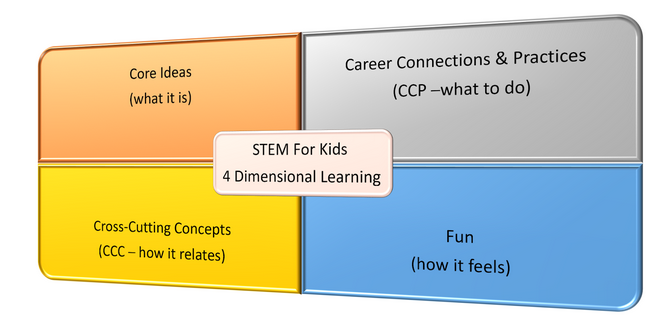
At STEM For Kids, we provide a fun learning experience for program participants. Brain research shows that fun is an important ingredient for learning and memory.
How do we do it?
The foundation of our STEM experience is a 4 Dimensional Learning that includes:
Core Ideas, Cross Cutting Concepts (CCCs), Career Connections and Practices (CCPs) and Fun
Our modular proprietary curricula allow custom delivery formats and spaces. Our activities provide quality STEM enrichment during in-school time or extended time (out-of-school time).
While our programs take place in a variety of settings – school, community centers, religious centers – we are always providing children a fun-filled learning experience.
A September 2019 research indicates that STEM For Kids programs are liked by children and their parents:
-
97% parents liked the variety of program themes.
-
91% parents enrolled their child because their child wanted it.
-
88% parents confirm child gained new knowledge, skills and abilities.
-
87% parents confirm that child is thinking critically about technology and creations.
Our comprehensive curriculum portfolio provide different courses to cover a variety of core ideas related to science education. For example:
-
our courses in Motion Commotion and Mechanical Engineering cover motion and stability, forces and interactions.
-
Aerospace Engineering covers motion, forces and earth science.
-
Captain Energypants courses cover energy and aspects of motion and forces.
-
Biomedical Engineering courses cover life science, forces and motion.
-
Environmental and Sustainable Engineering courses cover ecosystems and energy.
Core Ideas related to the following are also covered through our children-friendly curricula:
-
Mathematical Practice – persevere in solving problems, model with math, reason abstractly and quantitatively, and make use of structure.
-
Language Arts Practice – comprehension, collaboration, presentation of knowledge and ideas.
-
Technology and Computer Science – computational thinking, using technology as a tool to practice teamwork, analyze and communicate, computing practice and programming, computer and communication devices, community, global and ethical impacts.
Our learning dimension of Career Connection and Practices (CCP), brings depth to the learning experience by emphasizing to children how the learning gets applied in real situations.
What CCPs do we cover?
Career Connections
The 4Cs
Engineering Design Projects
Research
Internet Safety
Our learning dimension of Cross Cutting Concepts (CCC) is derived from the Next Generation Science Standards (NGSS). The CCCs emphasize how the learning relates to other ideas and learning heuristics.
What CCCs do we cover?
Patterns
Cause and Effect
Systems and Models
Scale, Proportion and Quantity
Structure and Function
The colors of STEM need the canvas of 4Cs to be effective. 4Cs represent the practices of Communication, Collaboration, Critical Thinking and Creativity. These practices are needed for success and individual growth. The 4Cs entail:
-
Communicating effectively to understand and to be understood.
-
Working creatively, designing and innovating.
-
Collaborating or working in teams to get things done.
-
Thinking critically to achieve higher order of thinking per the Bloom’s Taxonomy.
